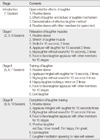Abstract
Purpose
This study was done to examine how laughter therapy impacts serotonin levels, QOL and depression in middle-aged women and to perform a path analysis for verification of the effects.
Methods
A quasi-experimental study employing a nonequivalent control group and pre-post design was conducted. Participants were 64 middle-aged women (control=14 and experimental=50 in 3 groups according to level of depression). The intervention was conducted five times a week for a period of 2 weeks and the data analysis was conducted using repeated measures ANOVA, ANCOVA and LISREL.
Results
Results showed that pre serotonin and QOL in women with severe depression were the lowest. Serotonin in the experimental groups increased after the 10th intervention (p=.006) and the rise was the highest in the group with severe depression (p=.001). Depression in all groups decreased after the 5th intervention (p=.022) and the biggest decline was observed in group with severe depression (p=.007). QOL of the moderate and severe groups increased after the 10th intervention (p=.049), and the increase rate was highest in group with severe depression (p<.006). Path analysis revealed that laughter therapy did not directly affect depression, but its effect was indirectly meditated through serotonin variation (p<.001).
Figures and Tables
Table 4
Effect of Laughter Therapy on Serotonin, Depression and QOL within Group (N=64)

*ANCOVA adjusted for pre score; †p<.05; ‡p<.01; §Contrast; Repeated Measures ANOVA of variance of contrast variables. Index 1,2 and 3 Inicate to 1: pre-test, 2: post-test after 5 times, and 3: post-test after 10 times; Cont.=Control group (n=14); Exp.=Experimental group (n=50); ND=None depression (n=15); MD=Moderate depression (n=19); SD=Severe depression (n=16); QOL=Quality of life.
References
1. Park GJ, Lee KH. A structural model for depression in middle-aged women. Korean J Women Health Nurs. 2002; 8(1):69–84.
2. Seligman MEP.
JS Yu
. Joy of psychology. Seoul: Phoenix;2007.
3. Min SY. Depression, self-esteem, and quality of life in a community population. J Korean Acad Psychiatr Ment Health Nurs. 2010; 19(1):1–10.
4. Beltran EI, Cheng LC, Chua NAA, Chua RNY, Chua SJC, Cinco MBA. New study on how laughter yoga decreases depression [Internet]. Bangalore, IN: Laughter Yoga International;2013. cited 2013 July 1. Available from: http://laughteryoga.org/english/news/news_details/468.
5. Serretti A, Lattuada E, Catalano M, Smeraldi E. Serotonin transporter gene not associated with psychotic symptomatology of mood disorders. Psychiatry Res. 1999; 86(1):59–65.
6. Lee SH. Serotonin here & now. Seoul: Joongang Books;2010.
7. Kim HJ. Effects of 20 weeks yoga on neurotransmitter in educable mentally retarded teenagers [master's thesis]. Seoul: Sookmyung Women's University;2006.
8. Dolgoff-Kaspar R, Baldwin A, Johnson MS, Edling N, Sethi GK. Effect of laughter yoga on mood and heart rate variability in patients awaiting organ transplantation: A pilot study. Altern Ther Health Med. 2012; 18(5):61–66.
9. Yoo JY, Choung SS. A study of effects factors on the relationship between well-being and quality of life dance education Korea: Focusing on mid life women. In : 265th Joint Conference of the Society of Korean Language Education / the Society of Korean Performance Art and Culture; 2008 May 17; Yongin: Yongin University;2008. p. 151–166.
10. Walter M, Hanni B, Haug M, Amrhein I, Krebs-Roubicek E, Muller-Spahn F, et al. Humour therapy in patients with late-life depression or Alzheimer’s disease: A pilot study. Int J Geriatr Psychiatry. 2007; 22(1):77–83. DOI: 10.1002/gps.1658.
11. Kim HS, Lee EJ. A study on the relation of laughter index, depression and anxiety in middle-aged women. Korean J Rehabil Nurs. 2006; 9(2):126–133.
12. Cho EA, Oh HE. Effects of laughter therapy on depression, quality of life, resilience and immune responses in breast cancer survivors. J Korean Acad Nurs. 2011; 41(3):285–293. DOI: 10.4040/jkan.2011.41.3.285.
13. Cha MY, Na YK, Hong HS. An effect of optimism, self-esteem and depression on laughter therapy of menopausal women. Korean J Women Health Nurs. 2012; 18(4):248–256. DOI: 10.4069/kjwhn.2012.18.4.248.
14. Park WY, Lee NH. The effects of 12 weeks regular exercise on functional fitness and quality of life in farmers. J Sport Leis Stud. 2013; 51:589–597.
15. Kim HW, Choi-Kwon S. Structural equation modeling on quality of life in pre-dialysis patients with chronic kidney disease. J Korean Acad Nurs. 2012; 42(5):699–708. DOI: 10.4040/jkan.2012.42.5.699.
16. Svenningsson P, Chergui K, Rachleff I, Flajolet M, Zhang X, El Yacoubi M, et al. Alterations in 5-HT1B receptor function by p11 in depressionlike states. Science. 2006; 311(5757):77–80. DOI: 10.1126/science.1117571.
17. Korean Academy of Nursing. The great encyclopedia of nursing science. Seoul: Korea Dictionary Research Publishing;1996.
18. Beck AT. Depression: Clinical, experimental, and theoretical aspects. New York, NY: Harper & Row;1967.
19. Yoon SY, Lim JH, Han C. Rating scales for measurement-based clinical practice of depression. Korean J Psychopharmacol. 2012; 23(4):136–146.
20. Ro YJ. An analytical study on the quality of life of the middle-aged in Seoul [dissertation]. Seoul: Yonsei University;1988.
21. Paik SN. A prediction model for the quality of life in mothers of children with nephrotic syndrom. Korean J Child Health Nurs. 2001; 7(3):280–297.
22. Dawson B, Trapp RG. Basic & clinical biostatistics. 2nd ed. Norwalk, CT: Appleton & Lange;1994.
23. Kline RB. Principles and practice of structural equation modeling. 2nd ed. New York, NY: Guilford Press;2005.
24. Kim GS. Amos Lisrel used analysis of causal research methodology. Seoul: Crbooks;2006.
25. Tander B, Cengiz K, Alayli G, Ilhanli I, Canbaz S, Canturk F. A comparative evaluation of health related quality of life and depression in patients with fibromyalgia syndrome and rheumatoid arthritis. Rheumatol Int. 2008; 28(9):859–865. DOI: 10.1007/s00296-008-0551-6.
26. Burchett SA, Hicks TP. The mysterious trace amines: Protean neuromodulators of synaptic transmission in mammalian brain. Prog Neurobiol. 2006; 79(5-6):223–246. DOI: 10.1016/j.pneurobio.2006.07.003.
27. Roh GT. Your brain younger-serotonin. Mon Marit Korea. 2012; 1:172–173.
28. Han SJ, Kim HK, Storfjell J, Kim MJ. Clinical outcomes and quality of life of home health care patients. Asian Nurs Res. 2013; 7(2):53–60. DOI: 10.1016/j.anr.2013.03.002.
29. Khang HS, Lim KS, Han DK. Difference of fMRI between the tickling and sensory stimulation using 3.0 tesla MRI. J Korea Contents Assoc. 2010; 10(2):286–294.




 PDF
PDF ePub
ePub Citation
Citation Print
Print






 XML Download
XML Download